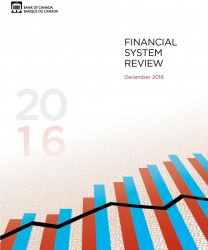Financial System Review - December 2016
This issue of the Financial System Review reflects the Bank’s judgment that the overall level of risk to Canada’s financial system remains largely unchanged from six months ago. The Bank continues to highlight two key vulnerabilities related to Canadian households: high levels of indebtedness and housing market imbalances. A third ongoing vulnerability is the potential for fragility in fixed-income market liquidity.

